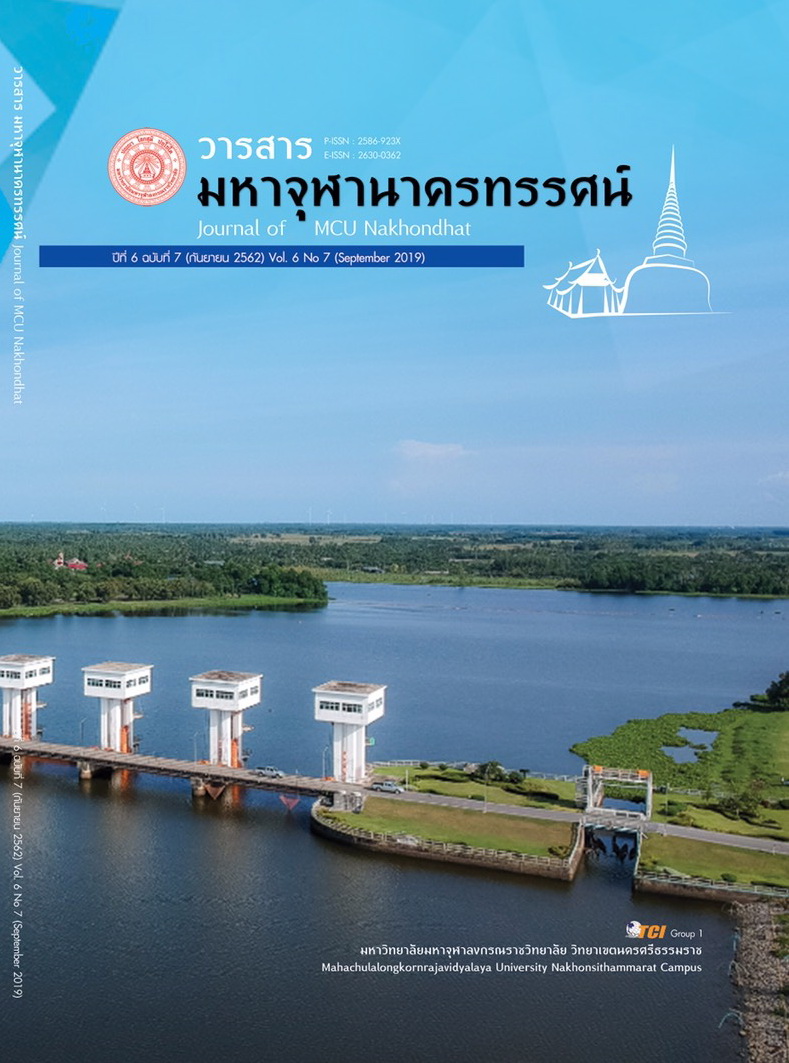ECONOMIC IMPACT OF BORDER TRADE IN THE NORTHEAST REGION AFTER DEBUT THE VIENTIANE NEW WORLD (VNW) PROJECT IN THE LAO PEOPLE'S DEMOCRATIC REPUBLIC
Main Article Content
Abstract
This research aims to study to study factors that affecting the northeast border trade economy after debute the Vientiane New World (VNW) and find ways to prevent the negative effects of the northeast border trade economy after debute the Vientiane New World (VNW) in the Lao People's Democratic Republic. The researcher used the mixed methodology that consisting of qualitative research by in-depth interviews 21 of hotel operators, importers, exporters, tour agencies, car rental operators in Udon Thani and Nong Khai and Council of Nong Khai and Udon Thani Chamber of Commerce. A result confirmation consisted in-depth interviews 3 of top-level officials that can push policies to control trade regulations and facilitation of border trade and border trade to summarize ways to prevent the negative effects of the northeast border trade economy for Vientiane New World (VNW). A quantitative research used 400 questionnaires on the opinions of the people of Laos PDR traveling to spend in Udon Thani and Nong Khai Province on Saturday - Sunday and the beginning of the month to inquire about the opinion of the people of Laos PDR and the trend of Thai shoppers in the future after the Vientiane New World (VNW) which uses statistics to analyze the data such as percentage, mean, Independent sample t-test, One-Way ANOVA F-test and Multiple Regression Analysis (MRA).
The results showed that:
the main factors affect the future shopping trend after the Vientiane New World (VNW) occurred at the significant level of 0.05 is the import tax saving factors with the value of F = 4.100 Sig. = 0.003 and the decision coefficient (R Square) equal to 0.360. While the factor of tax cost reduction freight saving factor and the factors of saving time in shopping does not affect the future shopping trend after the Vientiane New World (VNW) is debute. Guidelines to prevent the negative impact of the northeast trade economy that corresponds to the context of the change cause from the new city in Vientiane, Lao PDR are as follows: 1) Raise the level of trade and service to meet standards keep up with the changing market trends focusing on personnel development, organizing activities for cooperation in tourism businesses and facilities. 2) Develop the city center of prosperity and border cities to support international links. 3) Developing people and society to be ready to changes from Chinese investment in Lao PDR for Thailand to be stable and live happily together and 4) adjust tax measures from the impact of the Lao government on importing goods from Thailand.
Article Details
References
Banphot Wirunrat. (2015, August 10). Dean of the Faculty of Commerce Sciences Burapha University. (interview, Interviewer)
Bitner, M. J. (1990). Evaluating service encounters; the effects of physical surroundings and employee responses. Journal of Marketing, 54(2), 69-82.
Chan, K. (1999). Hukou and non-Hukou migrations in China: Comparisons and contrasts. International. Journal of Population Geography, 5(6), 425-448.
Chutha Thienthai. (2012). The impact of the ASEAN community on Thai business and strategies for setting up. Retrieved August 26 , 2019, from https://www. thai-aec.com/311#ixzz3ZuP1qCbh
Department of International Trade Promotion. (2014). Bureau of Market Development Economic Community ASEAN and Asia.Bangkok: Department of International Trade Promotion.
Department of Trade Negotiations. (2012). Lao People's Democratic Republic. Bangkok: Ministry of Commerce.
Exim Bank of Thailand. (2013). AEC in focus. Bangkok: Business Research Department Export Import Bank of Thailand.
Farkhod, T. (2006). Uzbakistan and Russia: Alliance against a mythic threat. Central Asia- Caucasus Analyst, 7(1), 3-4.
International Institute for Trade and Development (ITD). (2015). Development of special economic zones in the border area suitable for Thailand. Retrieved August 25 , 2019, from https://cpdhost.cpd.go.th/cpd/thaiasean coop/download/Thai/Articlesรูปแบบการพัฒนาเขตเศรษฐกิจพิเศษบริเวณชายแดนที่เหมาะสมกับประเทศไทย.pdf
Lovelock, C. H., & Wright, L. (1999). Principles of service marketing and management. New Jersey: Pearson Education.
Ministry of Tourism and Sports. (2011). National Tourism Development Plan 2012-2016. Bangkok: Ministry of Tourism and Sports.
Nopparat Wongwittayaphanich Chitra Rojprasertkul and Sermsit Chomedsri. (2011). Thai Border Trade Market Development: A Case Study of Rong Kluea Market Sa Kaew Province. Chiang Mai: Institute for Public Policy Studies, Chiang Mai University.
Office of Industrial Economics. (2011). Regional Industrial Development Plan for Action Plan 4. Border Industry Development Plan n.d.
Office of the National Economic and Social Development Board. (2012). Border Trade Report in the past 6 months (October 2011-2012). Bangkok: Bureau of Strategic Planning and Area Development Planning.
Pierre, O., & Penner, G. (2009). It's all Chinese to me: An overview of culture & etiquette in China. North Clarendon: Tuttle.
Prasert Wichitnopparat. (2014). Attitudes of Lao consumers towards potential products and services for export of Thai SMEs. Bangkok: Office of Small and Medium Enterprises Promotion.
Senate Secretariat Foreign Language Office. (2015). Knowing ASEAN. n.d.
Songrit Phonngern. (2009). Expanding the role of China and investment in the Mekong River. Ubon Ratchathani: Mekong Sub-regional Social Research Center, Faculty of Liberal Arts Ubon Ratchathani University.
Thanyathip Sripana. (2010). Mekong Sub-region: Tourism trade route. Bangkok: Asian Studies Institute Chulalongkorn University.

